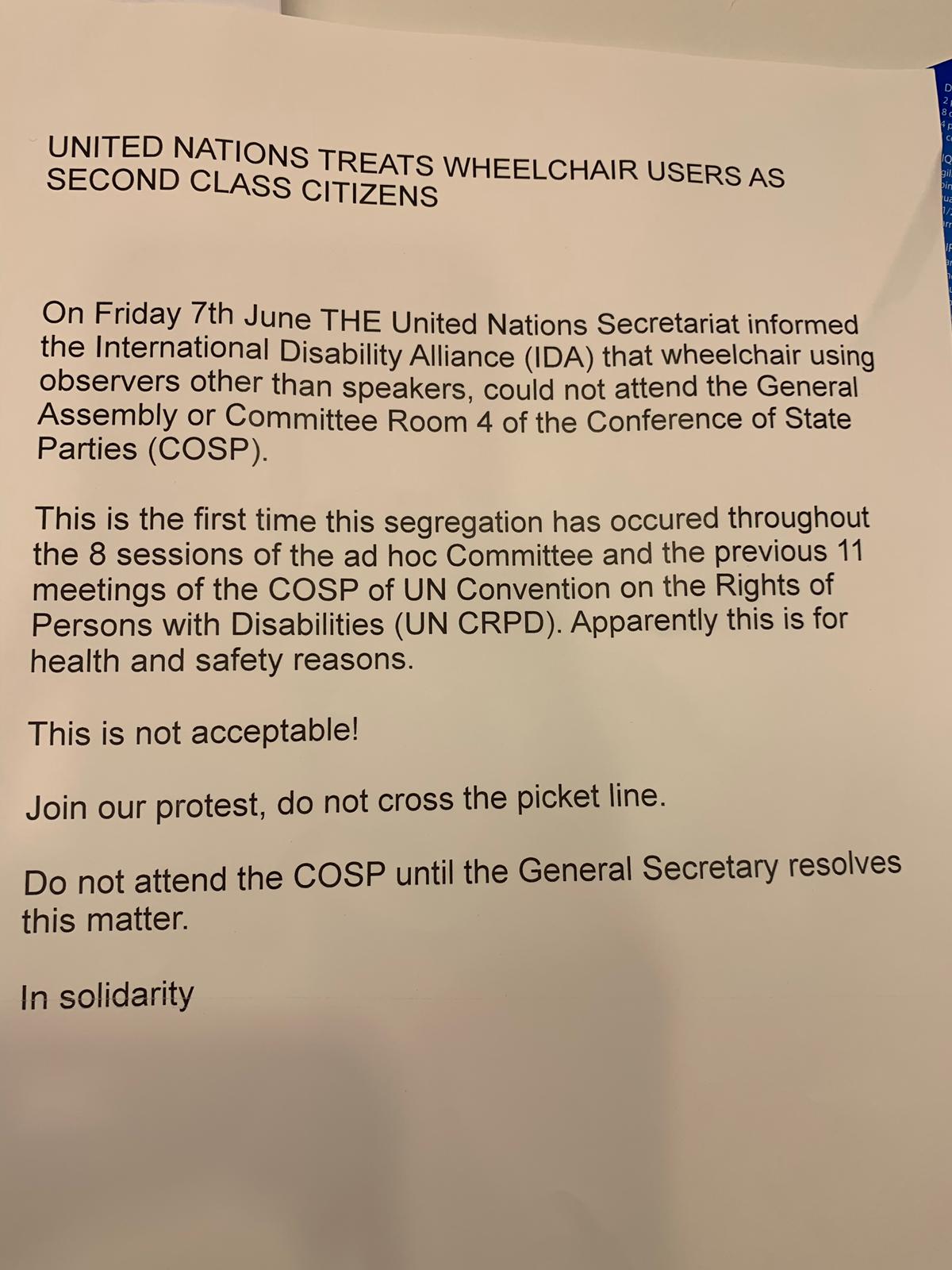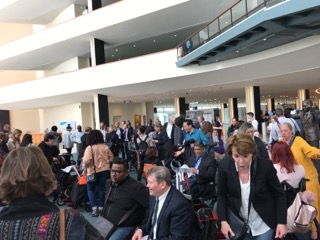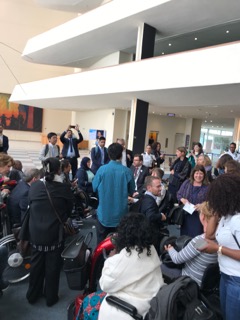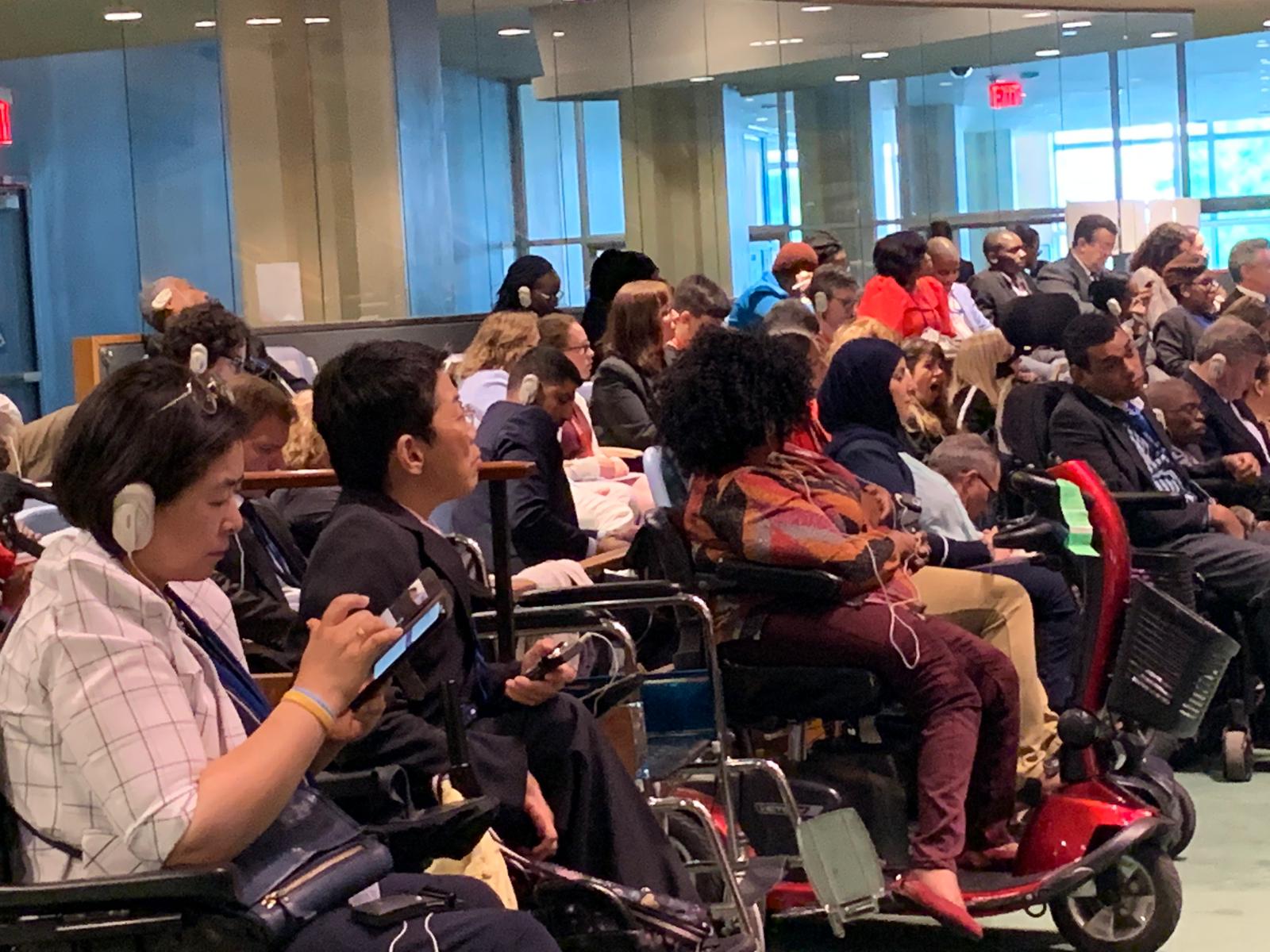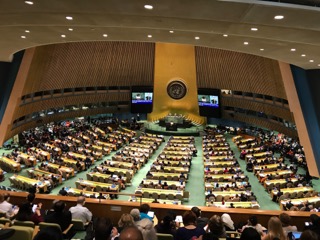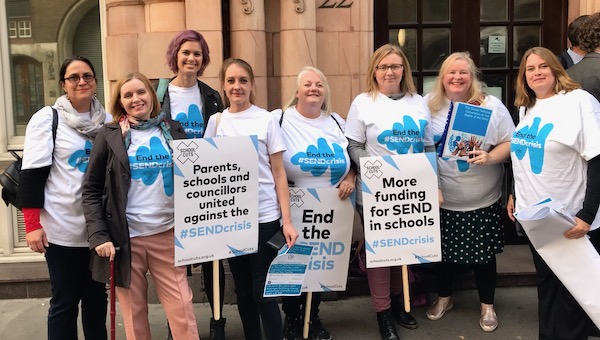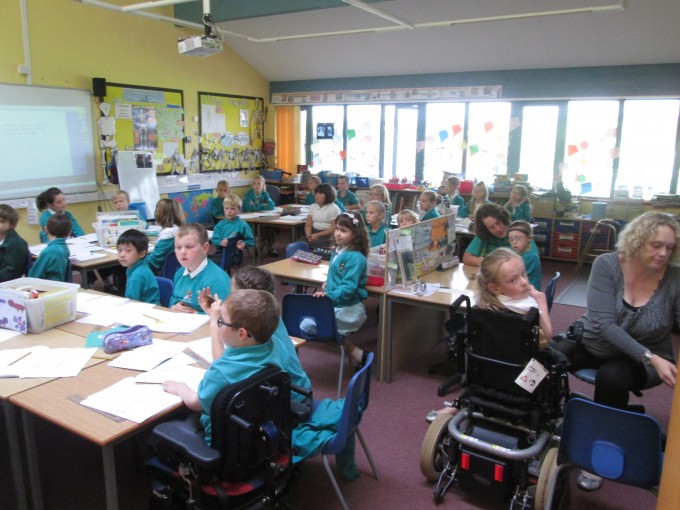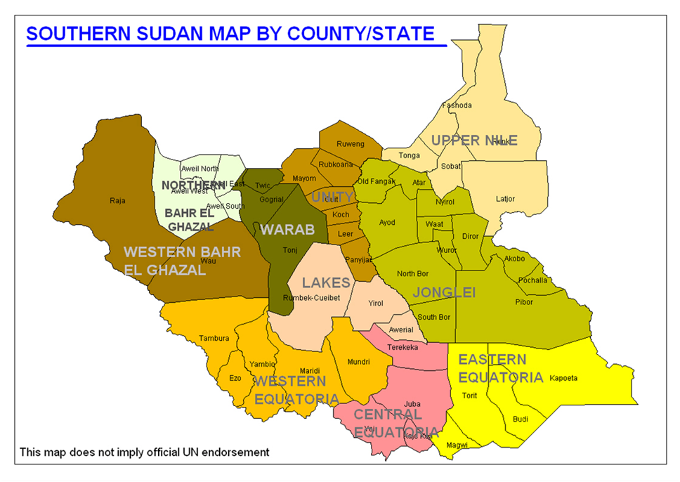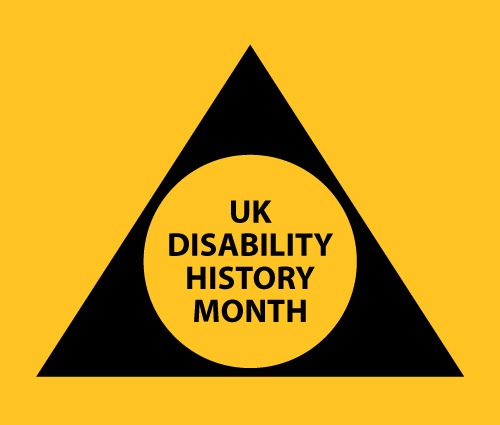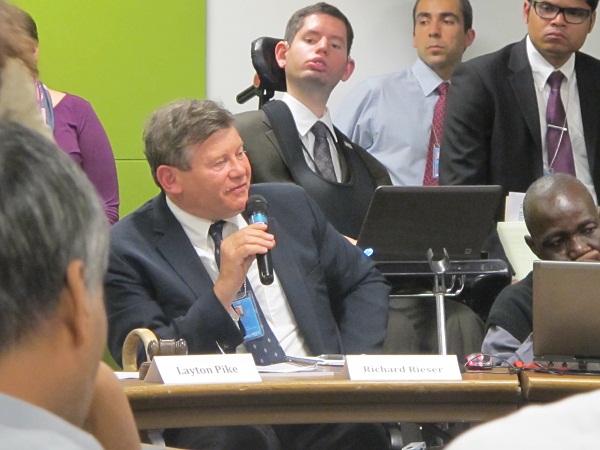Developing an Inclusive Education Policy in the Labour Party Richard Rieser www.worldofinclusion.com
The 2017 Manifesto committed to developing a National Education Service based on inclusivity. The Labour Party Consultation Document ‘Early Years, Education and Training’, currently (April-June 2018) out for members and wider views, is silent on the Inclusive Education issue. The 2017 Manifesto further stated “ we will deliver a strategy for children with special educational needs and disabilities (SEND) based on inclusivity, and embed SEND more substantially into training for teachers and non-teaching staff, so that staff, children and their parents are properly supported”. This is again not mentioned in the Consultation Document. The Manifesto also committed to signing into UK Law the United Nations Convention on the Rights of Persons with Disabilities. This means developing an Inclusive Education System and removing the current reservations, interpretations and obstacles to implementation of Article 24 –Education. The Labour Party is also committed to a Social Model approach to disability and in education this means developing inclusion.
There is considerable evidence from research in the UK and around the world that including disabled children and young people with the full range of impairments is successful, particularly where well planned, funded and staff are well trained . I have been observing and filming inclusion working across the UK and beyond for the last 30 years and I have witnessed children with multiple impairments being successfully included . It boils down to attitudes and where there is a ‘can do’ attitude it can happen in all sorts of environments. But even where this does not occur, disabled students do better academically than those segregated into special schools. This is the case for those with cognitive and social emotional and mental health impairments, as well as those with physical and sensory impairments. From 1997 to around 2004-2006 the Labour Government had a policy of Inclusive Education but they did not defend it and allowed it to be undercut. The pressures of the Tories, Standards Agenda, reduction in central support teams, high stakes testing and the wish from special schools to expand, all undercut the policy and the Labour Party did not know how to develop and defend it. This must not happen again. See graph below.
The Coalition and Tory Governments had a commitment to end the ‘bias to inclusive education’ and a moratorium on special school closures. Although the Children and Families Act 2014 (Part 3) reaffirmed the presumption of mainstreaming for those children and young people with a Statement or Education Health and Care Plan (ECHP), in 2015, for the first time in 25 years, there were more students in these categories attending provision outside of mainstream than in. The trend has continued with a further increase in students directed/seeking provision outside mainstream. There remains a huge variation by a factor of 9 in the placement of students with a Statement or EHCP in special school environments across different Local Authorities, as is shown in Table 1. This derives from geography-large rural distances to special schools and conscious efforts by local politicians to be more inclusive. Traditional Labour areas generally have high segregation as setting up special schools was seen as something to be municipally proud of. Now this is seen as a denial of human rights.
Table 1 Percent of School Students from Local Authority in Special Schools DFE SFR 22 2017 Mean 1.1039%*
Most Segregating LAs Least Segregating LAs *includes students in
special schools (maintained, academies, independent & non-maintained) Table 5
Torbay 2.06% Havering 0.64%
Stoke-on-Trent 1.87% Kensington and Chelsea 0.56%
Leicestershire 1.86% York 0.54%
Knowsley 1.82% Cornwall 0.48%
Middlesbrough 1.67% City of London 0.38%
Wirral 1.66% Bradford 0.30%
South Tyneside 1.66% Isles of Scilly 0.29%
Stockton-on-Tees1.64% Newham 0.22%
When the United Nations Convention on the Rights of Persons with Disabilities, UNCRPD, was first adopted by the United Nations and ratified by the UK Government in 2009, the meaning of Article 24 and its interpretation lacked clarity. In 2016, the UN Committee on the Rights of Persons with Disabilities adopted General Comment No 4 . This now has the status of international law and makes it clear what is expected by state parties with regard to implementing inclusive education.
The General Comment states what inclusive education is:-
1. A process of addressing and responding to the diverse needs of all children.
2. Recognises all children can learn.
3. Identification and removal of barriers.
4. Presence, full participation, accessibility, attendance and achievement of all students, especially those excluded or marginalized.
5. Builds positive relationships, friendships and acceptance.
Recognition of inclusion as the key to achieving the right to education has strengthened over the past 30 years, and is enshrined in the Convention on the Rights of Persons with Disabilities (herein after: the Convention), the first legally binding instrument to contain a reference to the concept of quality inclusive education. Sustainable Development Goal (SDG) 4 also affirms inclusive quality and equitable education. Inclusive education is central to achieving high quality education for all learners, including those with disabilities, and for the development of inclusive, peaceful and fair societies. Furthermore, there is a powerful educational, social and economic case to be made. Only inclusive education can provide both quality education and social development for persons with disabilities, and a guarantee of universality and non-discrimination in the right to education.
A recent UNESCO publication defined Inclusive Education as a process that helps to overcome barriers limiting the presence, participation and achievement of learners and strengthening the capacity of the education system to reach out to all learners. However, this generalised approach is in danger of missing the development of a pedagogy which also can meet the specific needs of disabled children and young people with different types of impairments.
A useful way of thinking about developing and training for inclusive education is to think about a twin track approach. The first track cover the general inclusion of all excluded and under achieving groups takes a broad brush approach based on General Inclusion Track. In teacher education this involves developing teaching and learning strategies that support: Valuing difference and diversity; Differentiation of materials and methods; Collaborative learning where pupils and teachers work together; Peer support where pupils help each other academically and socially and challenge negative language and behaviour; Flexible curricula as well as the provision of classroom and assessment materials; An anti-bias curriculum that challenges traditional gender, tribal , class and disability perspectives; Sufficient time for meaningful learning and rewarding of effort compared to Individuals previous achievements; The creation of a stimulating and interesting multi-sensory learning environment; A child-centred approach with teacher reflection.
The second Impairment Specific track is based on fulfilling the Article 24 duty to provide appropriate individual support and reasonable accommodations or reasonable adjustments under the UK Equalities Act (2010). This recognizes that the above approaches on their own will not work equally for all children with disabilities, as they require reasonable accommodations and support arising from their impairments. These adjustments are specific to the type of impairment a child/young person has. Within this track, the teacher would learn to identify the loss of physical or mental function with a basic screening tool, and have a working knowledge of the range of adjustments that can be implemented in the classroom. Below is a list, although not comprehensive, of the tools available for teachers to use with their students with disabilities:
a) Visually Impaired or Blind – Glasses, magnification glasses, Braille, tactile maps and diagrams, audio tapes/CDs and text to talk, mobility training, large print documents and paperwork, audio description, modified orientation and creation of fixed points in class, creation of auditory environments, talking instruments, colour contrasts, and identification of hazards such as steps; b) Deaf and Hearing Impaired- Finger spelling and basic sign language, interpretation, Oral-lip reading, basic Hearing Aid maintenance, strong emphasis on visual environment, additional time and support with abstract concepts and maths; c) Deafblind – Some of the tools listed above in a) and b), Deafblind Language, provision of interpreters, creation of tactile environments; d) Physical Impairments -Adapting doorways and furniture, creation of an accessible infrastructure as well as accessible toilet and washing facilities, maintaining safe storage of equipment, provision of personal assistance, diet and medication resources, and rest time space; e) Specific learning difficulties- Creation of colour overlays and backgrounds, providing easy read texts, story tapes and text to talk, allowing the use of spell-checkers, concrete objects, and breaking activities down into small doable steps; f) Speech and Communication Difficulty/Impairment – Facilitated Communication, Augmented Communication low and high tech, pointing, switching, talkers, information grids; g) General Cognitive Impairment- Pictograms, small steps curriculum, easy read, scaffolding, Makaton, symbols, information grids, concrete objects, individual programme; h) Mental Health Impairment- Counselling and personal support, differentiated behaviour policy, empathy, quiet space, circle of friends; i) Behaviour impairment- Circle of friends, structured environment and day, differentiated behaviour policy, chill out space and mentoring. Such pedagogy needs backing up by specialist inclusion teachers working out of local resource centres as peripatetic experts.
The right to inclusive education encompasses a transformation in culture, policy and practice in all formal and informal educational environments, to accommodate the differing requirements and identities of individual students, together with a commitment to remove the barriers that impede that possibility. It involves strengthening the capacity of the education system to reach out to all learners. It focuses on the full and effective participation, accessibility, attendance and achievement of all students, especially those who, for different reasons, are excluded or at risk of being marginalized. Inclusion involves access to and progress in high-quality formal and informal education without discrimination. It seeks to enable communities, systems and structures to combat discrimination, including harmful stereotypes, recognize diversity, promote participation and overcome barriers to learning and participation for all by focusing on well-being and success of students with disabilities. It requires an in-depth transformation of education systems in legislation, policy, and the mechanisms for financing, administration, design, delivery and monitoring of education. The UNCRPD does not mention ‘special education needs’, as this is rooted in an oppressive history based on eugenics and separation that has scarred generations of disabled people.
The UN CRPD Committee highlights the importance of recognising the differences between exclusion, segregation, integration and inclusion. Exclusion occurs when students are directly or indirectly prevented from or denied access to education in any form. Segregation occurs when the education of students with disabilities is provided in separate environments designed or used to respond to a particular or various impairments, in isolation from students without disabilities. Integration is a process of placing persons with disabilities in existing mainstream educational institutions, as long as the former can adjust to the standardized requirements of such institutions. Inclusion involves a process of systemic reform embodying changes and modifications in content, teaching methods, approaches, structures and strategies in education to overcome barriers with a vision serving to provide all students of the relevant age range with an equitable and participatory learning experience and environment that best corresponds to their requirements and preferences. Placing students with disabilities within mainstream classes without accompanying structural changes to, organisation, curriculum and teaching and learning strategies, does not constitute inclusion. Furthermore, integration does not automatically guarantee the transition from segregation to inclusion, Figure 1. (para 10 GC No.4)
The core features of inclusive education according to General Comment No 4 are :
1. Whole systems approach: education ministries must ensure that all resources advance inclusive education.
2. Whole educational environment: committed leadership introduces and embeds the culture, policies and practices to achieve inclusive education at all levels.
3. Whole person approach: flexible curricula, teaching and learning methods adapted to different strengths, requirements and learning styles.
4. Supported teachers
5. Respect for and value of diversity: everyone welcomed equally. Effective measures prevent abuse and bullying.
1. Learning-friendly environment: accessible environment where everyone feels safe, supported, stimulated and able to express themselves, with a strong emphasis on involving students themselves in building a positive school community.
2. Effective transitions: learners receive support, reasonable accommodation and equality regarding assessment, examination procedures and certification of their attainments on an equal basis with others.
3. Recognition of partnerships and monitoring (para. 12 GC No.4).
The Government have been using academisation and free schools to set up more segregated provision. Local Authorities in England are prevented from making rational planned decisions for SEN provision, both in special schools and in setting up mainstream resource bases and are now being forced to bid to set up free special schools. As of March 2018, there were 264 special school academies, a further 75 applications in the pipeline, 27 free special schools, a further 55 in the pipeline and Alternative Provision free schools 79 open and a further 31 in the pipeline.
A much larger group of students(1.14 million) are disabled with needs to be met in mainstream schools through SEN School Support. However, exclusion rates are 7 times higher for permanent and 6 times higher for fixed term exclusions than those with no SEN. Many excluded students are now in Alternative Provision permanently, rather than short term, as envisaged. Increasing numbers are being unlawfully off rolled and there is also a rise in those being home educated. The fixed term exclusion figure for sponsored secondary academies is three times higher than for non academies. Inflexible behaviour policies-three strikes and you are out, with a failure to differentiate behaviour policies are leading to many exclusions in breach of the equality duties for disabled students.
The funding crisis in our schools is particularly hitting provision for those on school support as teaching assistants and the facility for 1:1 and small group work disappears from our schools. EHC Plans are being cut as desperate Councils seek unlawfully to cut resources to spread them more thinly.
Failure by schools to take seriously their duties under the Equalities Act towards disabled students are leading to increasing discrimination and unfair treatment. Failure to implement the general Equality Duty and to make reasonable adjustments or protect disabled students from harassment and bullying are also helping to make schools less habitable for disabled students. The narrowing of curriculum, getting rid of course work and raising the bar on high stakes testing is leading to an increasing number of disabled children on SEN support being excluded or refused admission on the spurious grounds that the school cannot meet need.
Despite the gloomy outlook many schools are still struggling to provide good inclusive education in a comprehensive approach. See for example Eastlea, Newham (https://youtu.be/cAAoWGi3AKk ) or Emersons Green Primary South Gloucestershire (https://youtu.be/w4B4CGopmZw ) or Wroxham Primary, Hertfordshire (https://youtu.be/NL-Y9L3U6gY)
How would an incoming Labour Government committed to developing an inclusive National Education Service begin to tackle this increasingly discriminatory, unfair and increasingly privatised education system? The work starts now by discussing and educating the Party and the public on the alternatives and their beneficial effects. At a recent seminar for the Labour Front bench on Inclusive Education arranged by Jeremy Corbyn, presented by myself and Micheline Mason, we put forward statistical indicators of the current increasingly segregated position in many areas. Micheline started by explaining the impact of exclusion and segregation on her life & development and why she was committed to her daughter, who has the same impairment, going to mainstream school. This was about the right to be human . The International Human Rights position was explained and after identifying current barriers to inclusion in England’s school system (figures 2 and 3), discussed some of the solutions needed if Labour were returned to power.
What is to be done?
The current cuts in school budgets are hitting the inclusive practice towards disabled young people particularly hard with cuts in teaching assistants, reduction in bought in specialists and growing class sizes which are leading to increased exclusions both official ( fixed term and permanent) and big increases in off-rolling( unlawful) are leading to a crisis in our schools.
This state of affairs could be the touchstone to connect with a wide mass of parents to argue that another way is possible. Developing values based on human rights and inclusion is the firm foundation to this transformation, but developing confidence in inclusion among schools staff, parents and young people is the key. In electing a Labour Government and implementing a National Education Service based on a principle of inclusion we will need to convince staff and parents that another way is possible and practicable. Running a special school and mainstream system is expensive. It is also wasteful of young people’s potential. As we transition from the current situation to an inclusive system, capacity building will be crucial. Many more resources and expertise can be released to make inclusion work; provided the high stakes testing is dismantled and children’s happiness is at the heart of learning, with a curriculum for all, we will be able to achieve an inclusive, friendly quality education system for all.
In order to prepare now:-
1. Immediately set up a policy advisory group to work on fleshing out important changes.
2. More vigorously challenge current Government.
3. Develop a national and local debate on future education with inclusion at its heart.
4. Challenge current anti-inclusion thinking inside the Labour Party and beyond.
Possible policy changes when in Government:-
1. Remove caveats to Article 24 UNCRPD.
2. Strengthen Parent Carer Forums and Young Disabled People’s Forums.
3. Develop and implement a National Inclusion Strategy following involving all departments in Ministry of Education and Local Authorities.
4. This strategy will need to be at least for 10 years and identify transitional mechanisms for a dual system whilst special and mainstream schools increasingly collaborate and
continually developing the capacity of all mainstream to include wider diversity of pupils and students.
5. Restore SEND funding as part of increasing school funding including a ring fence on school SEN Support.
6. Introduce broad and balanced curriculum, including Equality and the necessity for peer support and collaboration.
7. Replace league table culture with moderated teacher assessment.
8. Introduce Access grant for school infrastructure and curriculum.
9. All schools and colleges fully accessible within 5 years.
10. Set up teacher led national curriculum and assessment review based on principles of Inclusive Education.
11. Challenge disabilist bullying/exclusions. Introduce disability equality into curriculum for all.
12. Develop behaviour policies based on emotional intelligence with differentiation ( No 3 strikes and out)
13. Restore Independent Appeal Panel for School Exclusions
14. Widen remit of the Ombudsman to cover admission of academies and to be the last resort of all complaints in schools and widen brief of Equality and Human Rights Commission to support
cases of discrimination in schools and colleges.
15. Introduce mandatory competencies on inclusive education on all Initial Teacher Training.
16. Require all serving teachers to undertake twin track training on the inclusion of disabled children/students.
17. Reverse Academies legislation. Take all schools/colleges back into local democratic control.
18. Incentivising equalities and inclusion by linking funding to value added for all students.
19. Develop financial incentives for mainstream schools to have resourced provision.
20. Reintroduce maintenance grants for all 16-19 year olds. Work towards all achieving a vocational or academic qualification.
21. Introduce Education and Equality Inspectorate with the power of fining schools in breach of the intentions of the Equality Act.
22. Develop longer term financial and organisational structure for inclusive education involving all providers.
23. Develop and fund more inclusive approaches to 19-25 education and training and link them to concrete measures for preparing for adulthood.
24. Restore and develop the Disabled Students Grant in Higher Education.
The above list is not exhaustive but has been put forward to initiate discussion in the SEA and the wider Labour Party.May 2018
The 2017 Manifesto committed to developing a National Education Service based on inclusivity lp with motion


